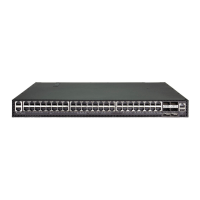C
HAPTER
35
| VLAN Commands
Configuring Protocol-based VLANs
– 1143 –
CONFIGURING PROTOCOL-BASED VLANS
The network devices required to support multiple protocols cannot be
easily grouped into a common VLAN. This may require non-standard
devices to pass traffic between different VLANs in order to encompass all
the devices participating in a specific protocol. This kind of configuration
deprives users of the basic benefits of VLANs, including security and easy
accessibility.
To avoid these problems, you can configure this switch with protocol-based
VLANs that divide the physical network into logical VLAN groups for each
required protocol. When a frame is received at a port, its VLAN
membership can then be determined based on the protocol type in use by
the inbound packets.
.
To configure protocol-based VLANs, follow these steps:
1. First configure VLAN groups for the protocols you want to use
(page 1124). Although not mandatory, we suggest configuring a
separate VLAN for each major protocol running on your network.
Do not add port members at this time.
2. Create a protocol group for each of the protocols you want to assign to
a VLAN using the protocol-vlan protocol-group command (Global
Configuration mode).
3. Then map the protocol for each interface to the appropriate VLAN using
the protocol-vlan protocol-group command (Interface Configuration
mode).
Table 139: Protocol-based VLAN Commands
Command Function Mode
protocol-vlan
protocol-group
Create a protocol group, specifying the supported
protocols
GC
protocol-vlan
protocol-group
Maps a protocol group to a VLAN IC
show protocol-vlan
protocol-group
Shows the configuration of protocol groups PE
show interfaces
protocol-vlan
protocol-group
Shows the interfaces mapped to a protocol group and
the corresponding VLAN
PE

